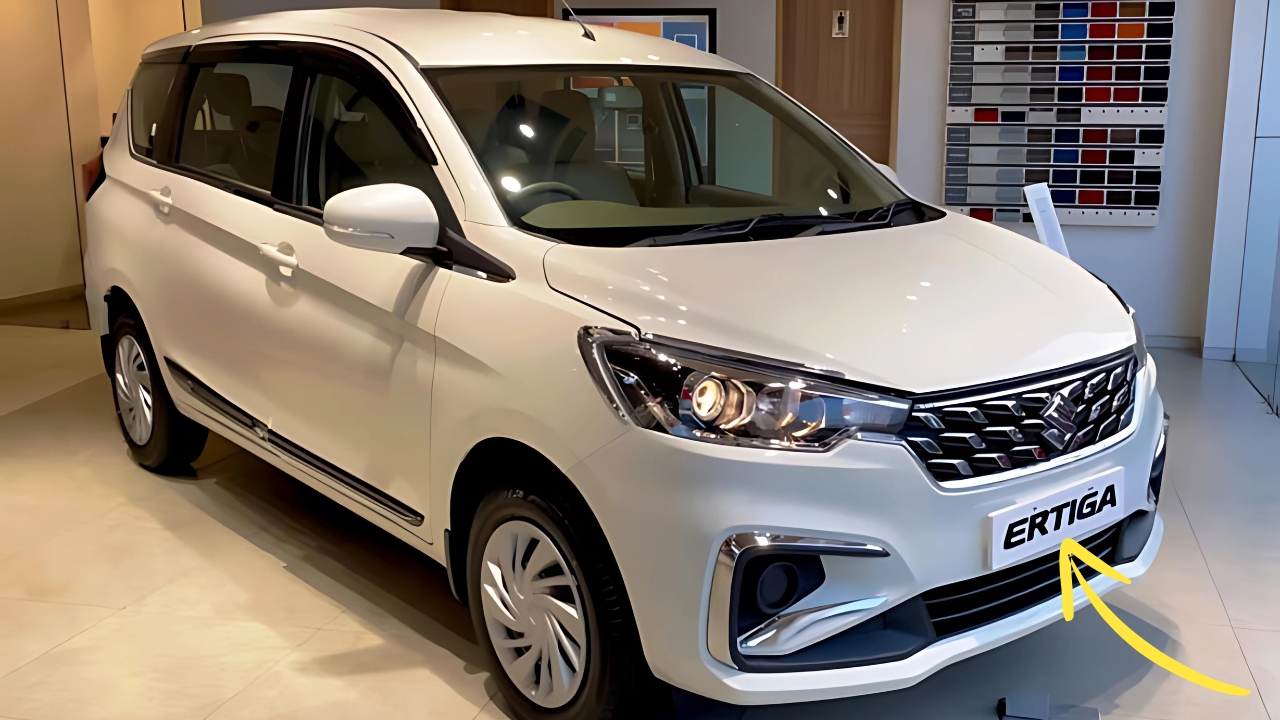Maruti Ertiga: Few vehicles have captured the practical needs of Indian families quite like the Maruti Suzuki Ertiga. Since its introduction in 2012, this compact MPV has carved a distinctive niche by offering three-row seating in dimensions manageable enough for urban navigation at a price point accessible to the middle class.
Having recently spent time with the refreshed model during an extended family gathering in Gujarat, I’ve gained renewed appreciation for how this unassuming vehicle addresses the specific mobility needs of its target audience with remarkable effectiveness.
Maruti Ertiga: Market Positioning: Understanding the Ertiga’s Role
To properly evaluate the Ertiga, one must first understand its strategic importance within Maruti Suzuki’s diverse portfolio.
Positioned between the Swift/Dzire and more premium offerings like the Grand Vitara, the Ertiga serves families requiring more seating capacity than traditional hatchbacks or sedans without stretching to the price points of larger vehicles like the Toyota Innova.
This positioning has proven remarkably successful, with the Ertiga consistently ranking among India’s best-selling utility vehicles despite increased competition from compact SUVs.
The vehicle’s focused approach to meeting specific family needs rather than chasing broader lifestyle aspirations represents Maruti’s characteristic pragmatism – delivering precisely what the target customer requires without unnecessary embellishment.
Design Philosophy: Functional Restraint
The Ertiga’s exterior design embraces a philosophy best described as functional restraint. The current generation, introduced in 2018 and refreshed in 2022, adopts more contemporary styling than its predecessor while maintaining clean, uncontroversial lines that age well.
The front fascia features a six-slat chrome grille flanked by projector headlamps, while the side profile reveals well-balanced proportions despite the three-row configuration.
What impresses most is how the design team has disguised the vehicle’s people-carrier purpose through thoughtful proportioning.
The sloping roofline and subtle character lines create visual interest without compromising interior space, while the gently flared wheel arches add a touch of substance to the otherwise straight-sided profile.
The 15-inch alloy wheels on higher trims fill their arches adequately without appearing unnecessarily large for the vehicle’s purpose.
During my time with the vehicle, several relatives commented on its “premium car” appearance – a testament to how effectively the design transcends the utilitarian associations sometimes attached to MPVs.
This matters significantly in the status-conscious Indian market, where vehicle choice often serves as a visible social signifier.
Space Utilization: Masterful Packaging
Step inside the Ertiga, and its most compelling attribute becomes immediately apparent. Despite relatively compact external dimensions (4395mm length, 1735mm width, 1690mm height), the interior offers genuinely usable space across all three rows – a testament to Suzuki’s expertise in efficient packaging.
The front seats provide good visibility and comfort for longer journeys, while the second row offers surprising spaciousness with sufficient headroom and legroom for adult passengers.
The 60:40 split design slides and reclines to balance space between second and third rows depending on occupant requirements.
The third row, while predictably less spacious, remains entirely usable for adults during shorter journeys or children on longer trips – a significant distinction from many compact SUVs where the third row proves practical only for emergency use.
During our family gathering, the Ertiga comfortably accommodated six adults for a 60-kilometer journey to a wedding venue without complaints – a real-world validation of its practical versatility.
The relatively low floor height compared to SUVs particularly benefited elderly family members, who appreciated the easier ingress and egress.
Storage solutions demonstrate thoughtful consideration of family needs. The dual glove boxes, large door pockets, seat-back pockets, and assorted cubbies throughout the cabin provide generous space for the accumulated items of family travel.
The 209-liter boot with all seats up expands to a substantial 550 liters with the third row folded, proving sufficient for our extended family’s luggage requirements despite initially appearing modest.
Driving Dynamics: Appropriate Capability
The Ertiga offers two powertrain options: a 1.5-liter naturally aspirated petrol engine producing 103 horsepower and 138 Nm of torque, available with either a 5-speed manual or 6-speed automatic transmission, and a CNG variant with slightly reduced output figures.
My experience was with the petrol automatic, which delivers adequate if unremarkable performance.
Urban maneuverability benefits from the relatively compact dimensions and light steering, making city navigation straightforward despite the three-row configuration.
Highway stability proves surprisingly good considering the tall proportions, with the relatively long wheelbase contributing to straight-line composure.
The suspension tuning clearly prioritizes comfort over dynamics, absorbing urban road imperfections effectively while maintaining reasonable body control during directional changes.
With six adults aboard, performance unsurprisingly dulled somewhat, requiring more thoughtful overtaking maneuvers, though never feeling dangerously underpowered.
The automatic transmission demonstrated smooth operation in typical driving, though more aggressive acceleration revealed some hesitation during kickdown. Engine refinement at cruising speeds impressed, with minimal intrusion into the cabin.
Fuel efficiency remained reasonable despite full occupancy and air conditioning use in warm conditions, returning approximately 14 km/l during our mixed driving – commendable figures for a fully-loaded three-row vehicle and a meaningful consideration for family budgets.
Feature Integration: Pragmatic Approach
The equipment list adopts the same pragmatic philosophy evident throughout the vehicle. The ZXi+ variant I experienced included a 7-inch touchscreen supporting wired Apple CarPlay and Android Auto, automatic climate control with roof-mounted rear vents for all three rows, keyless entry and start, and a reasonably effective four-speaker audio system.
Safety features include dual front airbags, ABS with EBD, electronic stability control, and rear parking sensors with camera guidance.
While not matching the more comprehensive safety packages of some competitors, this covers essential bases for the vehicle’s intended usage and price positioning.
Notably absent are features like sunroof, ventilated seats, wireless phone charging, and advanced driver assistance systems – omissions that reflect the vehicle’s focus on practical essentials rather than luxury or technological showcasing.
During our family use, none of these absences detracted from the fundamental utility the vehicle provided.
Ownership Economics: The Value Equation
Perhaps the Ertiga’s most compelling attribute beyond its practical design is its ownership economics. Maruti’s legendary service network ensures maintenance support virtually anywhere in India, while parts availability and relatively simple mechanical architecture keep ongoing costs reasonable.
The CNG option provides particularly attractive running costs for high-usage customers like family businesses or rural healthcare workers, with fuel expenses approximately 60% lower than petrol equivalents.
This economic consideration often proves decisive for practical-minded buyers focused on total ownership costs rather than initial feature comparisons.
Maruti Ertiga: Purpose-Built Excellence
The Maruti Ertiga ultimately succeeds by embracing its nature as a purpose-built family vehicle without pretension or unnecessary frills.
Its focused approach to delivering specifically what its target audience needs – genuine three-row seating, fuel efficiency, reasonable comfort, and manageable dimensions – creates a compelling proposition for practical-minded buyers.
In a market increasingly dominated by style-focused compact SUVs that often compromise function for fashion, the Ertiga’s straightforward execution of its core mission represents a refreshing clarity of purpose.
For Indian families prioritizing pragmatic mobility over image projection, this unassuming MPV continues to offer perhaps the most rational transportation solution available.

